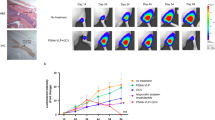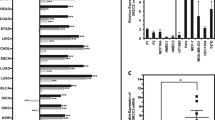Abstract
We have previously shown that a dual system for controlling gene expression that relies both on transcriptional regulation and DNA recombination mediated by the site-directed recombinase, Flp, effectively controls the expression of a gene encoding diphtheria toxin (DT-A). In this study, we investigated the use of a chimeric modified enhancer/promoter sequence of the human prostate-specific antigen (PSA) gene to regulate DT-A expression in human prostate cancer cells in culture, in xenografts derived from these cells, and in autochthonous tumors in TRAMP mice. Following adenoviral delivery of DNA encoding PSA promoter-driven Flp recombinase and DT-A, we demonstrate that this transcriptional/DNA recombination control strategy effectively activates DT-A expression in a manner that correlates with the amount of PSA and androgen in cells. Significantly, the size of xenografts was reduced by 50%, and tumor cells in TRAMP mice died following intratumoral injection of DT-A viruses. Direct injection of virally-delivered DT-A into normal mouse prostates resulted in a dramatic reduction in the size of the gland. Our results suggest that the PSA promoter-driven Flp recombinase regulatory system will allow for targeted death of PSA-expressing cells. When combined with newly developed strategies for targeted gene delivery, this approach holds promise as an effective systemically-administered therapy for metastatic prostate cancer.






Similar content being viewed by others
References
American Cancer Society. Facts and figures. http://www.cancer.org.
Collier RJ . Diphtheria toxin: mode of action and structure. Bacteriol Rev 1975; 39: 54–85.
Maxwell IH, Maxwell F, Glode LM . Regulated expression of a diphtheria toxin A-chain gene transfected into human cells: possible strategy for inducing cancer cell suicide. Cancer Res 1986; 46: 4660–4664.
Peng W, Verbitsky A, Bao Y, Sawicki JA . Regulated expression of diphtheria toxin in prostate cancer cells. Mol Therapy 2002; 6: 537–545.
Wu L et al. Chimeric PSA enhancers exhibit augmented activity in prostate cancer gene therapy vectors. Gene Ther 2001; 8: 1416–1426.
Greenberg NM et al. Prostate cancer in a transgenic mouse. Proc Natl Acad Sci USA 1995; 92: 3439–3443.
Shirakawa T et al. In vivo suppression of osteosarcoma pulmonary metastasis with intravenous osteocalcin promoter-based toxic gene therapy. Cancer Gene Ther 1998; 5: 274–280.
Lee EJ, Jameson JL . Cell-specific Cre-mediated activation of the diphtheria toxin gene in pituitary tumor cells: potential for cytotoxic gene therapy. Human Gene Ther 2002; 13: 533–542.
Coen JJ, Zietman AL, Thakral H, Shipley WU . Radical radiation for localized prostate cancer: local persistence of disease results in a late wave of metastases. J Clin Oncol 2002; 20: 3199–3205.
Han M et al. Biochemical (prostate specific antigen) recurrence probability following radical prostatectomy for clinically localized prostate cancer. J Urol 2003; 169: 517–523.
Smaletz O, Scher HI . Outcome predictions for patients with metastatic prostate cancer. Semin Urol Oncol 2002; 20: 155–163.
Anderson DG et al. A polymer library approach to suicide gene therapy for cancer. Proc Natl Acad Sci USA 2004; 101: 16028–16033.
Dibler MS, An Hahrton G . Suicide gene therapy: possible implications in haematopoietic disorders. J Intern Med 2001; 249: 359–367.
Schlemmer HP et al. Alterations of intratumoral pharmacokinetics of 5-fluorouracil in head and neck carcinoma during simultaneous radiochemotherapy. Cancer Res 1999; 59: 2363–2369.
Vassaux G, Marin-Duque P . Use of suicide genes for cancer gene therapy: study of the different approaches. Expert Opin Biol Ther 2004; 4: 519–530.
Thomson JM, Parrott WA . pMECA: a cloning plasmid with 44 unique restriction sites that allows selection of recombinants based on colony size. BioTechn 1998; 24: 922–928.
Acknowledgements
We thank Cheryl Hobbs for helpful comments on the manuscript, Lisa Laury-Kleintop for assistance with fluorescent microscopy, and Gwendolyn Gilliard for excellent technical assistance. We are grateful to Lily Wu (UCLA) for a plasmid containing the PSE-BC promoter, Michael Carey (UCLA) for pBCVP2G5-lucNSN, Susan Dymecki (Harvard) for pFRT2neolacZ, A Francis Stewart (EMBL, Heidelberg) for p22EDT1, J Miyazaki (Kyoto U) for pCX-EGFP, and R Rodriguez (Johns Hopkins U) for 293DTRP#2 cells. This work was supported by NIH Grant CA90841 (JAS).
Author information
Authors and Affiliations
Additional information
Supplementary Information accompanies the paper on Gene Therapy website (http://www.nature.com/gt)
Supplementary information
Rights and permissions
About this article
Cite this article
Peng, W., Chen, J., Huang, YH. et al. Tightly-regulated suicide gene expression kills PSA-expressing prostate tumor cells. Gene Ther 12, 1573–1580 (2005). https://doi.org/10.1038/sj.gt.3302580
Received:
Accepted:
Published:
Issue Date:
DOI: https://doi.org/10.1038/sj.gt.3302580
- Springer Nature Limited
Keywords
This article is cited by
-
Neomorphic DNA-binding enables tumor-specific therapeutic gene expression in fusion-addicted childhood sarcoma
Molecular Cancer (2022)
-
Rad51 Promoter-Targeted Gene Therapy Is Effective for In Vivo Visualization and Treatment of Cancer
Molecular Therapy (2012)
-
A tunable dual‐promoter integrator for targeting of cancer cells
Molecular Systems Biology (2010)
-
Rapid Optimization of Gene Delivery by Parallel End-modification of Poly(β-amino ester)s
Molecular Therapy (2007)
-
Rapid Optimization of Gene Delivery by Parallel End-modification of Poly(β-amino ester)s
Molecular Therapy (2007)




